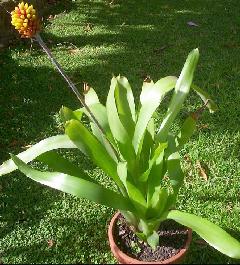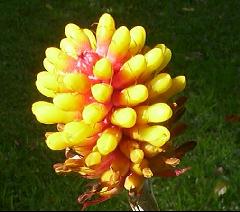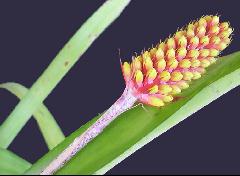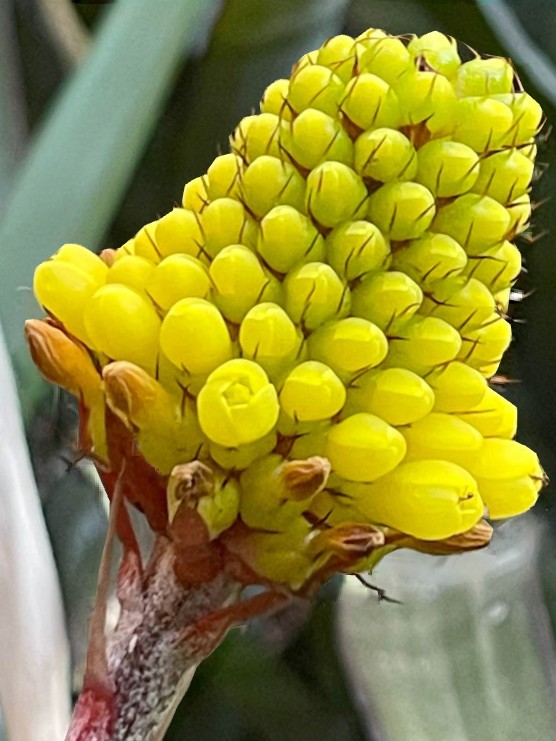Aechmea calyculata
Click thumbnails for full size, scaled to a new window.
Aechmea calyculata
Species, or possibly Ortgiesia sub-species, from South-East Brazil




| Ian Hook 06/02 |
Ian Hook 05/06 |

Aechmea calyculata (E. Morren.) Baker, Jour. Bot. London 17: 232. 1879.
Macrochordium nudiusculum K. Koch, Wochenschr. 7: 176.1864; nomen.
Hoplophytum calyculatum E. Morren, Belg. Hortic. 15: 162, pl. II. 1865.
Billbergia lutea Cat. Linden 27. 1865; no.22: 22. 1869; nomen (! W. Robyns).
Macrochordium luteum Regel & Linden, Gartenflora 16: 161, pl. 544. 1867. Type. Linden Hortus s n (LE ? n v).
Hohenbergia calyculata (E. Morren) Baker, Saunders, Ref. Bot. 4: pl. 286. 1871.
Aechmea selloana Baker, Handb. Bromel. 60. 1889. Type. South Brazil, Sellow 4008 (B, photo F 11323).
Echinostachys pineliana sensu Wittmack, Bot. Jahrb. 13(Beibl. 29): 14. 1891; non Brongniart ex Planchon, 1854-58. Based on Schimper 659 and 886 (B, lost), Blumenau, Santa Catarina, Brazil, 1886.
Aechmea thyrsigera Spegazzini, Physis 3: 45. 1917; Castellanos, Lilloa 10: 449. 1944. Type. Fragran, Misiones, Argentina, Spegazzini s n (BA cultivated, clonotype ?).
Aechmea gamosepala Castellanos, An. Mus. Nac. Hist. Nat. Buenos Aires 36: (49). 1929; non Wittmack, 1891.
Chevalieria thyrsigera (Spegazzini) Mez, Pflanzenreich IV. 32: 95. 1934.
Desc from S&D
Leaves 5-16 in a funnelform rosette, 3-10 dm long, covered with minute pale appressed scales;
Sheaths subelliptic, slightly darker than the blades, inconspicuous;
Blades ligulate, broadly rounded and minutely apiculate, 3-4 cm wide, laxly and minutely serrulate, green.
Scape erect, slender, white-flocculose;
Scape-bracts lower ones lax, ovate, acute or acuminate, entire, membranaceous, pale yellow, the upper denser and massed beneath the inflorescence, very narrowly triangular, acuminate, usually red.
Inflorescence usually simple but sometimes digitate from a few sessile densely aggregated spikes, spike broadly ovoid or sub cylindric, broadly obtuse, 40-65 mm long, 30-50 mm in diameter, many-flowered, more or less white-flocculose except the petals.
Floral bracts narrowly triangular, acuminate to a slender pungent spine, entire, the lower from slightly shorter than the sepals to exceeding them, the upper much smaller;
Flowers sessile.
Sepals strongly asymmetric, 3-5 mm long without the slender 3-4 mm terminal spine, connate for 1/3 to 1/2, yellow;
Petals subelliptic, broadly rounded, 12 mm long, bearing 2 scales at base, yellow; Stamens included;
Ovary broadly ellipsoid, ca 5 mm long, epigynous tube short; placentae subcentral; ovules obtuse.
Type. Linden Hortus s n (clonotype, LG; photo GH), cultivated from Libon, from Santa Catarina, Brazil, 1 Mar 1865.
Distribution. Terrestrial on banks and epiphytic in forest, 100-700 m alt, southern Brazil and northeastern Argentina.
BRAZIL. Sellow bromel. 29 (P); 71 (P). Espirito Santo: 26 Aug 1962. A. Seidel 64 (HBR). Santa Catarina: Dusen 11918 (S); F. Mueller s n (K); Serra de Jaragua, 31 May 1897, Schwacke13360 (RB); Rio Ita¬pocu, 4 Sep 1897, Schwacke 13368 (RB); Blumenau, May 1950, Reitz 3562 (HBR); 3599 (HBR); 3640 (HBR); 14 Apr 1951, 3978 (HBR); Ribeirao Grande, Taio, 16 Dec 1950, Reitz 3992 (HBR, US); Itapiranga, 3 Feb 1951, Reitz 3859a (HBR); sd, 4753 (! Reitz, inflorescence branched); Corupa, 25 Apr 1951, A. Seidel 7 (HBR); Lauro Muller, 3 Apr 1957 , Smith & Klein
2350 (HBR, US); Anita Garibaldi, 12 Apr 1963, Reitz & Klein 14743 (HBR, US). ARGENTINA. Misiones: Rio Dorado, 17 Feb 1907 , Spegazzini s n (BAB).
Protologue
92. Aechmea selloana Baker, Handb. Bromel. 60. 1889. Type. South Brazil, Sellow 4008 (B, photo F 11323).
Leaves thin, lorate, 2 ft. long, 1 ¼ in. broad at the middle, rounded at the apex to a small cusp ; marginal prickles nearly obsolete. Peduncle slender, much shorter than the leaves. Inflorescence a very dense subglobose head 1 ½ in. long; flower-bracts broad ovate, spine-pointed, ¼ in. long; ovary with calyx ¼ in. long; sepals ovate, scarcely cuspidate.
Hab. South Brazil, Sello 4008 ! (Herb. Reg. Berol.). Habit of A. calyculata, but the sepals not mucronate.
Aechmea calyculata (E. Morren) Baker, var. variegata, T. Strehl, Divul. Mus. Cienc. Tecnol. – UBEA/PUCRS, Porto Alegre. N. 9, p. 25-32, dec. 2004
Type: Brasil, Rio Grande do Sul, Machadinho, Mata de galeria, margens do rio Uruguai, 9 V 2000. T. Strehl, 1327 (Holotype. HAS 43043).
Paratype: Local coletor e data de origem nao citados, em cultivo na colecao do Jardim Botanico da FZB, floresceu em cultivo, 15.V.2000: (HAS 43044).
A Aechmea calyculata var. calyculata cui affinis est, set in lamina foliarum striata differt.
LEAVES ca. 9-11;
BLADES subereta, not narrowed at the sheath, rounded at the apex, 22-30 x 2-3 cm wide. at the base, green, with yellow longitudinal lines and stripes.
INFLORESCENCE subglobose, apex rounded, 3-4 x 2-3 cm;
FLORAL BRACTS narrow-triangular, red, the one at the base exceeding the flowers;
FLOWERS 1.4 cm; subsessile;
SEPALS asymmetrical, yellow, 0.5-0.8 cm;
PETALS yellow, 0.9-1 x 0.3-0.4 cm;
STAMENS included.
The name of the variety makes reference to the stripes and longitudinal lines in the blades of the leaves.
It inhabits the broad-leaved forest of Alto Uruguay, epiphytic. It blooms between March and May.
Aechmea calyculata var variegata stands out from the typical variety by the leaves having lines or longitudinal bands (two or various) yellowish or clear green (vs. green leaves without lines or bands).
Updated 29/05/21




